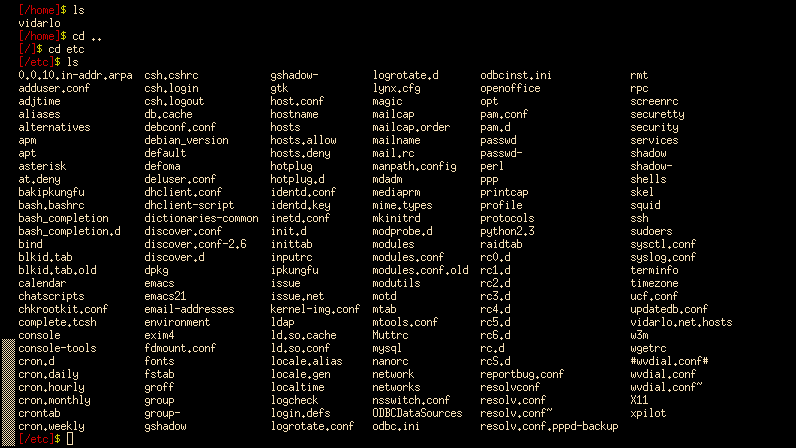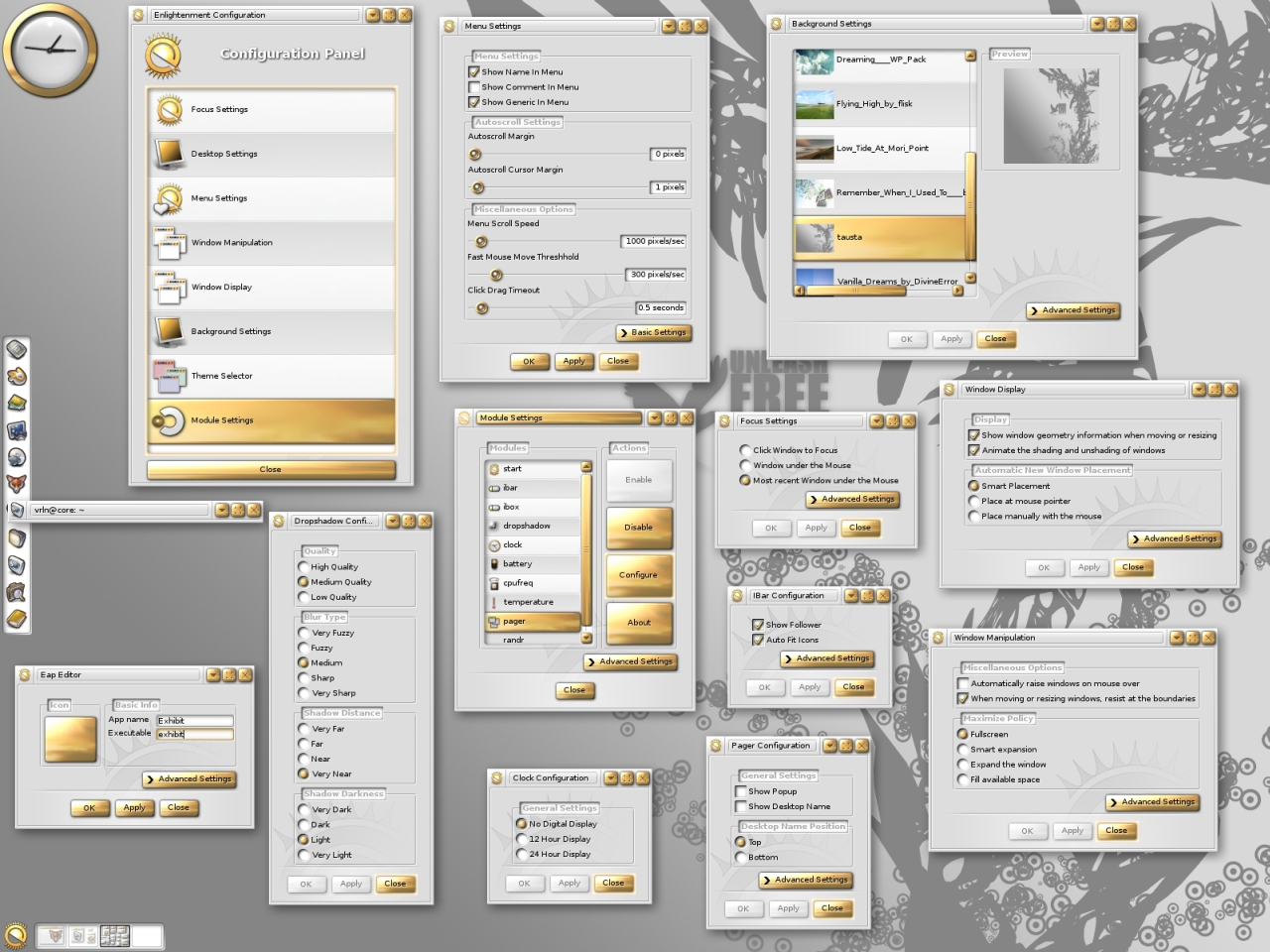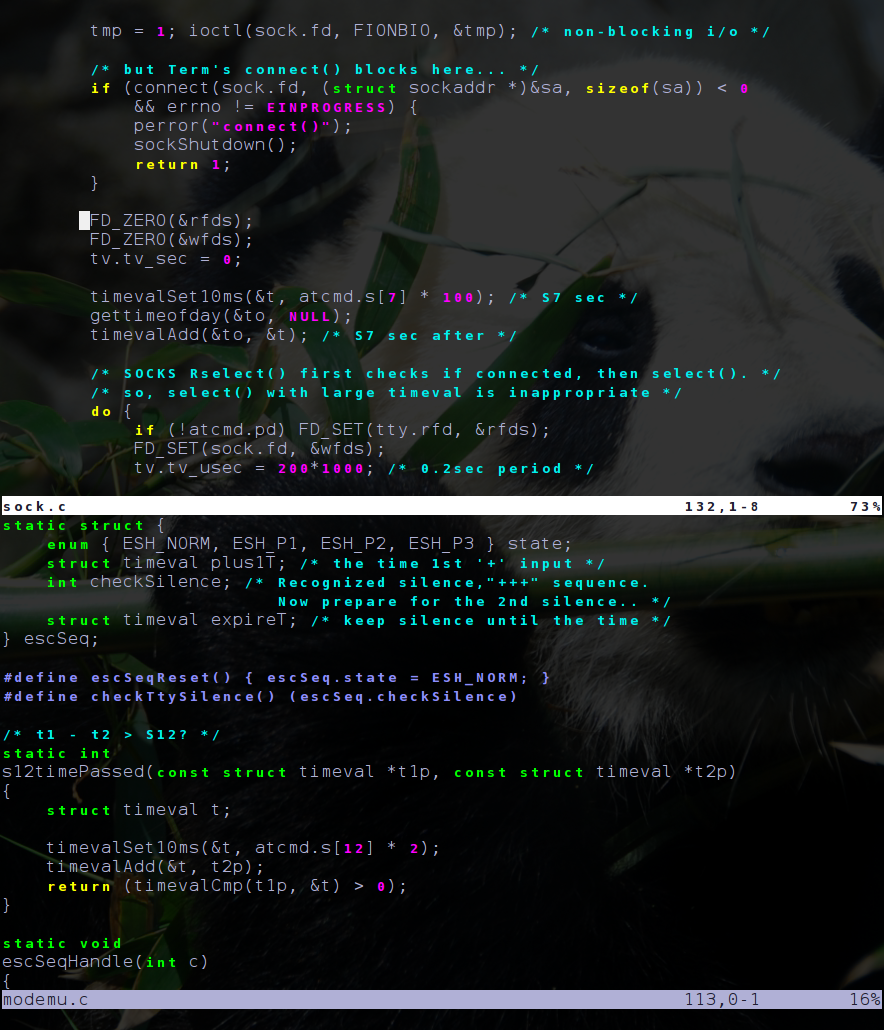|
List Of Terminal Emulators
This is a list of notable terminal emulators. Most used terminal emulators on Linux and Unix-like systems are GNOME Terminal on GNOME and GTK-based environments, Konsole on KDE, and xfce4-terminal on Xfce as well as xterm. Character-oriented terminal emulators Unix-like Command-line interface * Linux console – implements a subset of the VT102 and ECMA-48/ISO 6429/ANSI X3.64 escape sequences. The following terminal emulators run inside of other terminals, utilizing libraries such as Curses and Termcap: * GNU Screen – Terminal multiplexer with VT100/ANSI terminal emulation * Minicom – text-based modem control and terminal emulation program for Unix-like operating systems * tmux – Terminal multiplexer with a feature set similar to GNU Screen Graphical =X11 and Wayland= Terminal emulators used in combination with X Window System and Wayland: * Alacritty – GPU accelerated, without tabs * GNOME Terminal – default terminal for GNOME with native Wayland ... [...More Info...] [...Related Items...] OR: [Wikipedia] [Google] [Baidu] |
Terminal Emulator
A terminal emulator, or terminal application, is a computer program that emulates a video terminal within some other display architecture. Though typically synonymous with a shell or text terminal, the term ''terminal'' covers all remote terminals, including graphical interfaces. A terminal emulator inside a graphical user interface is often called a terminal window. A terminal window allows the user access to a text terminal and all its applications such as command-line interfaces (CLI) and text user interface (TUI) applications. These may be running either on the same machine or on a different one via telnet, ssh, dial-up, or over a direct serial connection. On Unix-like operating systems, it is common to have one or more terminal windows connected to the local machine. Terminals usually support a set of escape sequences for controlling color, cursor position, etc. Examples include the family of terminal control sequence standards known as ECMA-48, ANSI X3.64 or IS ... [...More Info...] [...Related Items...] OR: [Wikipedia] [Google] [Baidu] |
Alacritty
Alacritty is a free and open-source GPU-accelerated terminal emulator focused on performance and simplicity. Consequently, it does not support tabs or splits and is configured by editing a text file. It is written in Rust and uses OpenGL (for performance). A similar terminal emulator that uses OpenGL is kitty. History Joe Wilm announced Alacritty in his blog on 6 January 2017. He describes it as "the result of frustration with existing terminal emulators. Using vim inside tmux in many terminals was a particularly bad experience. None of them were ever quite fast enough". He found urxvt and st difficult to configure and criticized their "inability to run on non- X11 platforms". With the release of version 0.2.0 in September 2018 Alacritty gained support for scrollback. In version 0.3.0, released in April 2019, Alacritty entered beta stage and support for Windows, text reflow, and clicking on URLs was added. In version 0.5.0, released in July 2020, a mode with vi keybind ... [...More Info...] [...Related Items...] OR: [Wikipedia] [Google] [Baidu] |
Terminator (terminal Emulator)
Terminator is an open-source terminal emulator programmed in Java. It is available on Microsoft Windows, macOS, Linux and other Unix systems that use the X Window System. Terminator will run on any modern POSIX system running Java 6 or later. Terminator is licensed under the GPL-2.0-or-later license. Terminator was originally written by Phil Norman, who produced a more-or-less usable replacement for rxvt on his own between 21 April 2004 and 28 May 2004; roughly a month of development time. Elliott Hughes took Phil's terminal emulation and used it as a base upon which he could experiment with advanced terminal emulator features and continues to actively develop Terminator. Martin Dorey ported Terminator to Cygwin. Features *Automatic Logging - Complete logs are automatically generated of all of the user's terminal sessions. * Drag & Drop - Text and URLs, and files from Finder/Nautilus/Windows Explorer can be dropped on Terminator to be inserted as text, with automatic quo ... [...More Info...] [...Related Items...] OR: [Wikipedia] [Google] [Baidu] |
Window Maker
Window Maker is a free and open-source window manager for the X Window System, allowing graphical applications to be run on Unix-like operating-systems. It is designed to emulate NeXTSTEP's GUI as an OpenStep-compatible environment. Window Maker is part of the GNU Project. Overview Window Maker has been characterized as reproducing "the elegant look and feel of the NeXTSTEP GUI" and is noted as "easy to configure and easy to use." A graphical tool called Wprefs is included and can be used to configure most aspects of the UI. The interface tends towards a minimalist, high performance environment directly supporting XPM, PNG, JPEG, TIFF, GIF and PPM icons with an alpha-channel and a right-click, sliding-scrolling application menu system which can throw off pinnable menus, along with window-icon miniaturization and other animations on multiple desktops. Menus and preferences can be changed without restarting. As with most window managers it supports themes and many are available. ... [...More Info...] [...Related Items...] OR: [Wikipedia] [Google] [Baidu] |
Window Manager
A window manager is system software that controls the placement and appearance of windows within a windowing system in a graphical user interface. Most window managers are designed to help provide a desktop environment. They work in conjunction with the underlying graphical system that provides required functionality—support for graphics hardware, pointing devices, and a keyboard—and are often written and created using a widget toolkit. Few window managers are designed with a clear distinction between the windowing system and the window manager. Every graphical user interface based on a windows metaphor has some form of window management. In practice, the elements of this functionality vary greatly. Elements usually associated with window managers allow the user to open, close, minimize, maximize, move, resize, and keep track of running windows, including window decorators. Many window managers also come with various utilities and features such as task bars, program l ... [...More Info...] [...Related Items...] OR: [Wikipedia] [Google] [Baidu] |
NeXTSTEP
NeXTSTEP is a discontinued object-oriented, multitasking operating system based on the Mach kernel and the UNIX-derived BSD. It was developed by NeXT Computer in the late 1980s and early 1990s and was initially used for its range of proprietary workstation computers such as the NeXTcube. It was later ported to several other computer architectures. Although relatively unsuccessful at the time, it attracted interest from computer scientists and researchers. It hosted the original development of the Electronic AppWrapper, the first commercial electronic software distribution catalog to collectively manage encryption and provide digital rights for application software and digital media, a forerunner of the modern "app store" concept. It is the platform on which Tim Berners-Lee created the first web browser, and on which id Software developed the video games ''Doom'' and '' Quake''. In 1996, NeXT was acquired by Apple Computer to succeed the classic Mac OS, by merging NeXTSTEP ... [...More Info...] [...Related Items...] OR: [Wikipedia] [Google] [Baidu] |
Unicode
Unicode, formally The Unicode Standard,The formal version reference is is an information technology standard for the consistent encoding, representation, and handling of text expressed in most of the world's writing systems. The standard, which is maintained by the Unicode Consortium, defines as of the current version (15.0) 149,186 characters covering 161 modern and historic scripts, as well as symbols, emoji (including in colors), and non-visual control and formatting codes. Unicode's success at unifying character sets has led to its widespread and predominant use in the internationalization and localization of computer software. The standard has been implemented in many recent technologies, including modern operating systems, XML, and most modern programming languages. The Unicode character repertoire is synchronized with Universal Coded Character Set, ISO/IEC 10646, each being code-for-code identical with the other. ''The Unicode Standard'', however, includes more th ... [...More Info...] [...Related Items...] OR: [Wikipedia] [Google] [Baidu] |
Mrxvt
The mrxvt program is a terminal emulator for X Window System. It provides DEC VT102 compatible terminals. mrxvt is based on rxvt version 2.7.11 CVS (in 2004), and features most of functionality of rxvt. Unlike rxvt, it provides multiple tabs. Like rxvt, mrxvt aims to be light, fast, flexible and does not depend on desktop environments like GNOME or KDE. The primary features of mrxvt include (but are not limited to) multiple tabs, dynamically changeable tab titles, customizable command for each tab, input broadcasting, fast pseudo-transparency with tinting, user supplied background images (XPM, JPEG, PNG), off-focus fading, text shadow, multiple style (NeXT, Rxvt, Xterm, SGI, Plain) scrollbars, XIM, multi-language support (Chinese, Korean, Japanese), Freetype font and logging. mrxvt does not have Unicode support, though a Unicode version is in development. The latest released version of mrxvt, which was released in 2008, is vulnerable to , which can cause the terminal to ... [...More Info...] [...Related Items...] OR: [Wikipedia] [Google] [Baidu] |
Enlightenment (software)
Enlightenment, also known simply as E, is a compositing window manager for the X Window System. Since version 20, Enlightenment is also a Wayland compositor. Enlightenment developers have referred to it as "the original eye-candy window manager." Enlightenment includes functions to provide a graphical shell and can be used in conjunction with programs written for GNOME or KDE. When used together with the Enlightenment Foundation Libraries (EFL), Enlightenment can refer to an entire desktop environment. History The first version of Enlightenment was released by Rasterman ( Carsten Haitzler) in 1997. Version 0.17, also referred to as E17, was in development for 12 years starting in December 2000 until 21 December 2012 when it was officially released as stable. During the development period it was also referred to as DR17 (Development Release 17). It is a complete rewrite on DR16 and was designed to be a full-fledged desktop shell, based on the new Enlightenment Foundation L ... [...More Info...] [...Related Items...] OR: [Wikipedia] [Google] [Baidu] |
Rxvt
Rxvt (acronym for our extended virtual terminal) is a terminal emulator for the X Window System, and in the form of a Cygwin port, for Windows. History Rxvt was originally written by Rob Nation and later extensively modified by Mark Olesen, who took over maintenance for several years. It is intended to be a slimmed-down alternate for xterm, omitting some of its little-used features, like Tektronix 4014 emulation and toolkit-style configurability. The latter refers to the Xt resource mechanism, e.g., for binding keys. Rxvt is an extended version of the older xvt terminal emulator by John Bovey of the University of Kent. The name originally stood for "Rob's xvt" (with XVT stands for 'X Virtual Terminal'), but was later re-dubbed "our xvt" (pronounced like the letters r-x-v-t). Features Aside from features such as those controlled by resource files, rxvt's terminal emulation differs from xterm in two important ways: *It emulates a VT102, rather than a VT220. That means that it ha ... [...More Info...] [...Related Items...] OR: [Wikipedia] [Google] [Baidu] |
Konsole
Konsole is a free and open-source terminal emulator graphical application which is part of KDE Applications and ships with the KDE desktop environment. Konsole was originally written by Lars Doelle. It ls licensed under the GPL-2.0-or-later and the GNU Free Documentation License. KDE applications, including Dolphin, Kate, KDevelop, Kile, Konversation, Konqueror, and Krusader, use Konsole to provide embedded terminal functionality via Kpart. Features * Built-in support for bi-directional text display. * Tabbed terminals. Tab titles update dynamically depending on the current activity in the terminal. * Translucent backgrounds * Split-view mode * Directory and SSH bookmarking * Customizable color schemes * Customizable key bindings * Notifications about silence or activity in a terminal * Incremental search * Can open Dolphin or the user's preferred file manager at the terminal program's current directory * Export of output in plain text or HTML format *Multiple profile su ... [...More Info...] [...Related Items...] OR: [Wikipedia] [Google] [Baidu] |




